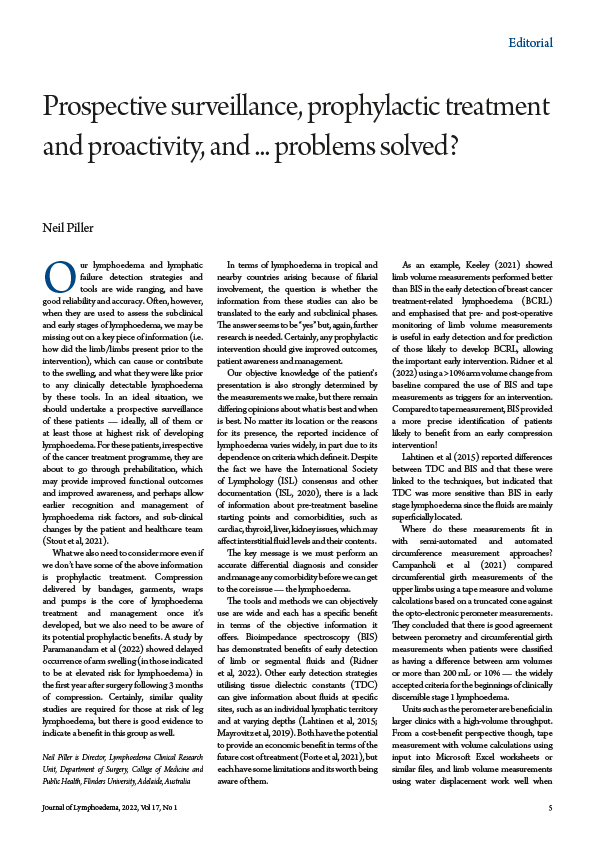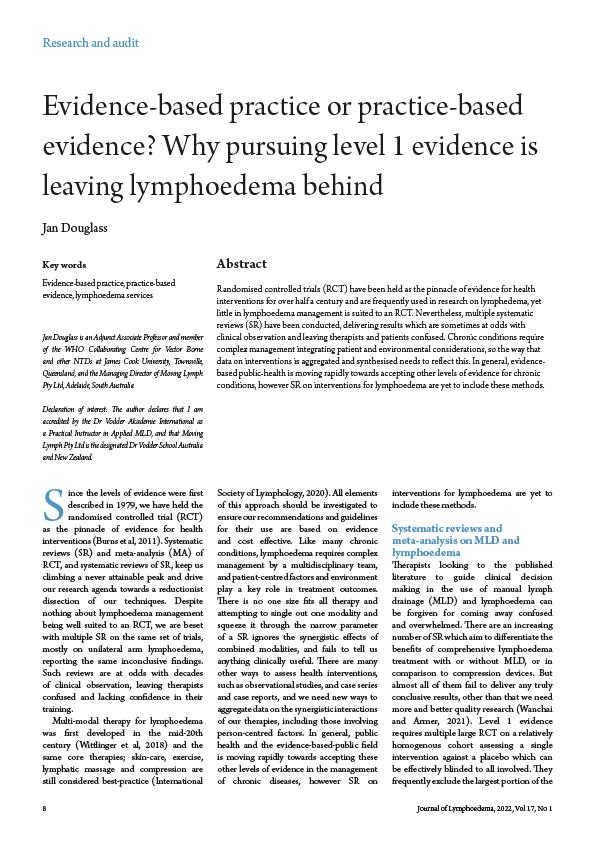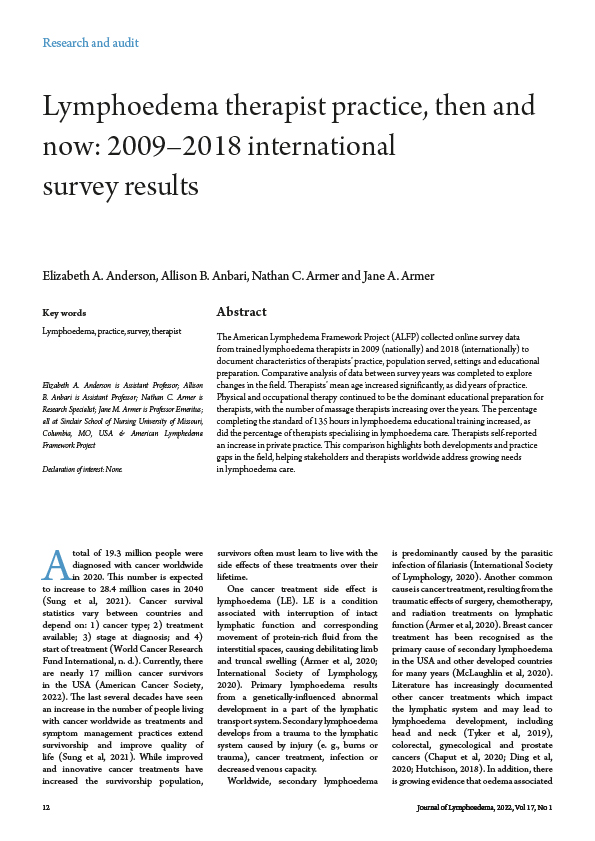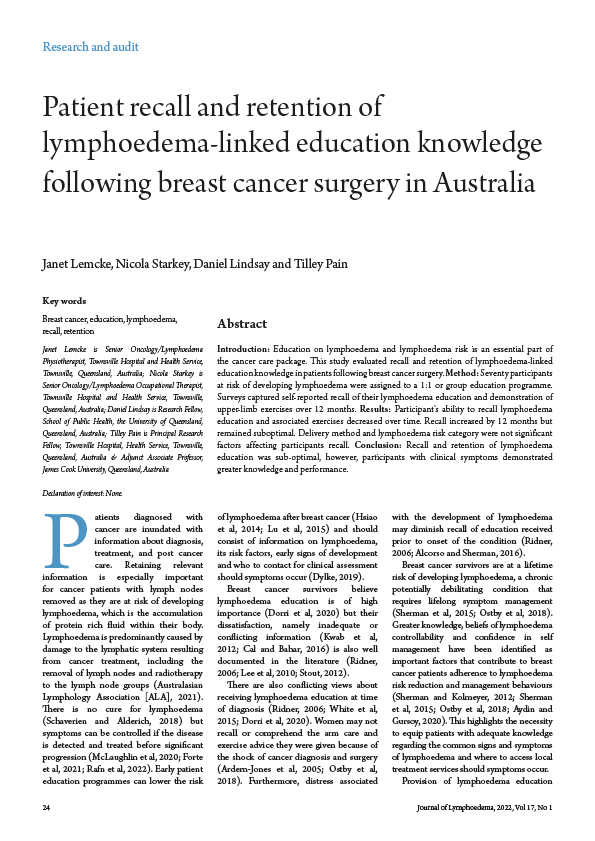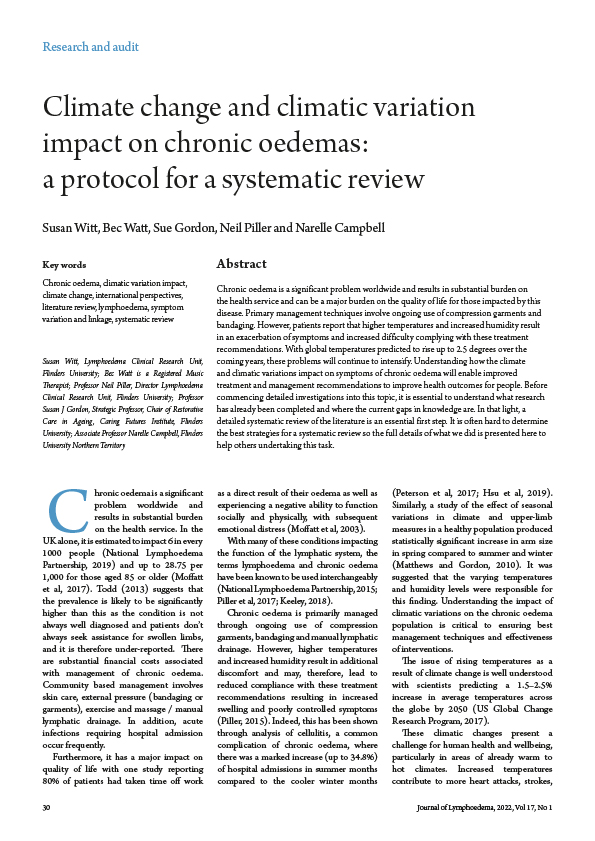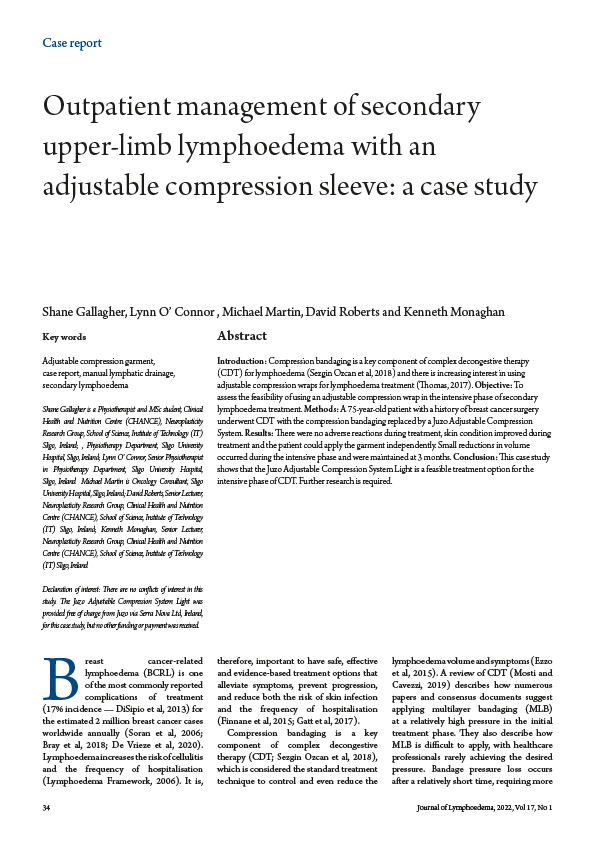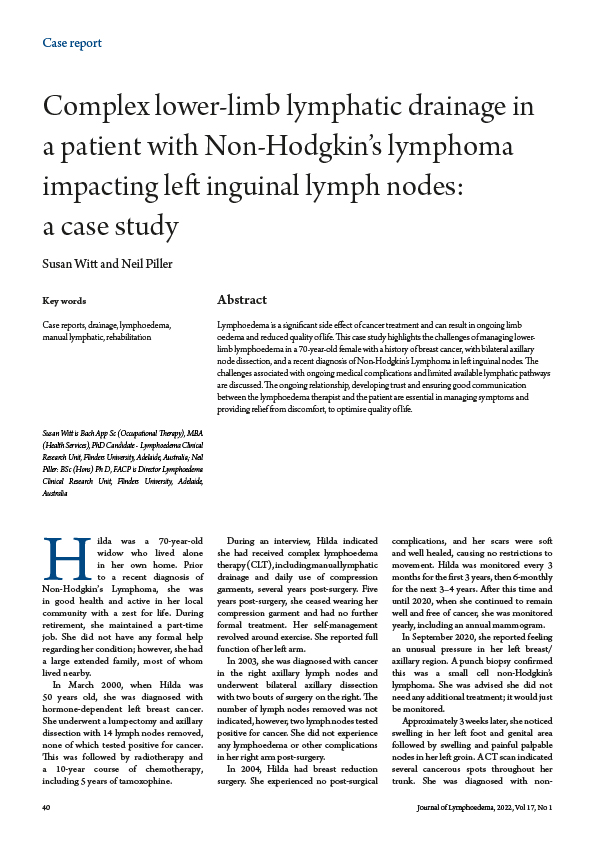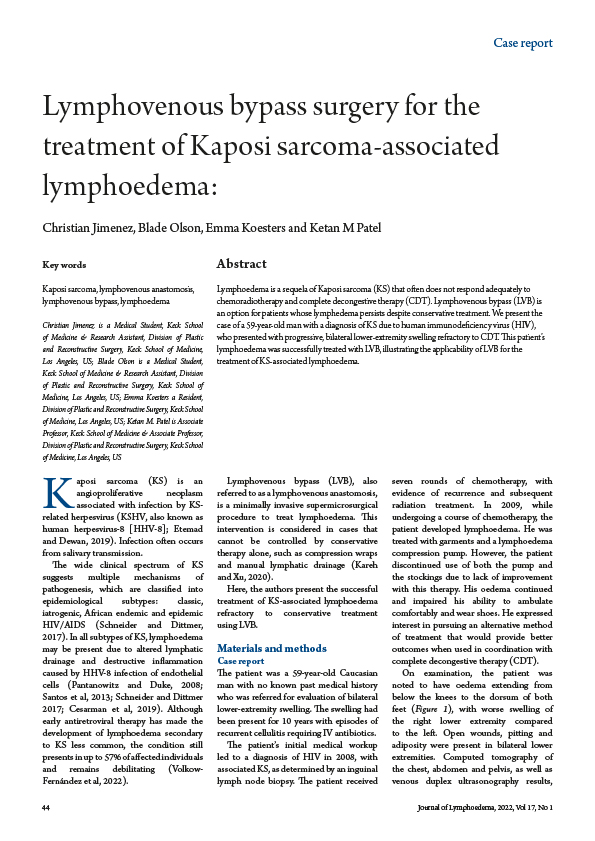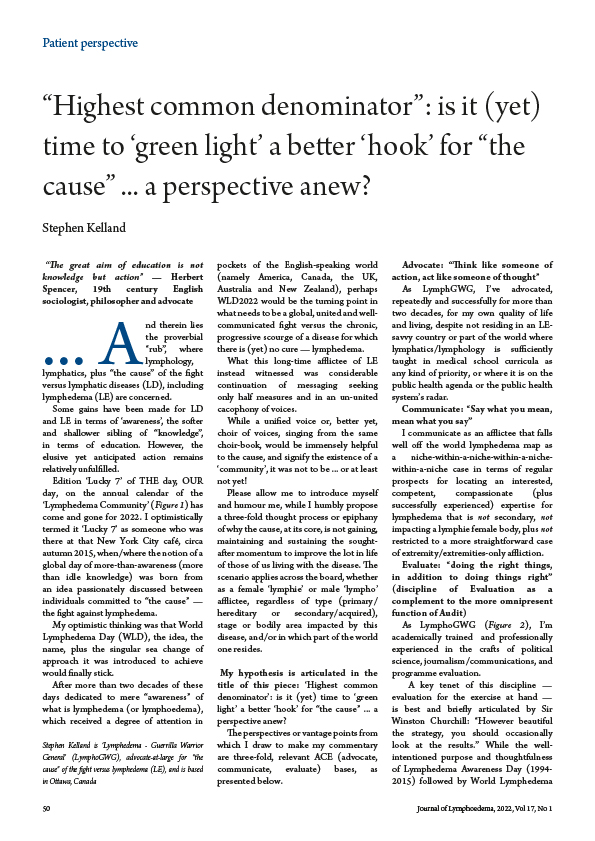Journal of Lymphoedema August 2022


Journal of Lymphoedema
Issue: 2022, Vol 17, No 1 , pages 5 – 54
Published date: 16 August 2022
The latest issue of the Journal of Lymphoedema explores a number of important topics from a number of Australian authors. These include the importance of surveillance and using whatever the tools you have regularly on the individual to the fact that evidence based therapy isn’t always improving the outcomes for clients and need to be driven by practice based evidence. Patient recall and retention of lymphoedema education is not always what you expect and perhaps lipoedema mimics pregnancy due to the hormonal changes and more.
Prospective surveillance, prophylactic treatment and proactivity, and… problems solved?
Our lymphoedema and lymphatic failure detection strategies and tools are wide ranging, and have good reliability and accuracy. O!en, however, when they are used to assess the subclinical and early stages of lymphoedema, we may be missing out on a key piece of information (i.e. how did the limb/limbs present prior to the intervention), which can cause or contribute to the swelling, and what they were like prior to any clinically detectable lymphoedema by these tools. In an ideal situation, we should undertake a prospective surveillance of these patients ” ideally, all of them or at least those at highest risk of developing lymphoedema. For these patients, irrespective of the cancer treatment programme, they are about to go through prehabilitation, which may provide improved functional outcomes and improved awareness, and perhaps allow earlier recognition and management of lymphoedema risk factors, and sub-clinical changes by the patient and healthcare team (Stout et al, 2021).
Evidence-based practice or practice-based evidence? Why pursuing level 1 evidence is leaving lymphoedema behind
Pages: 8 – 11
Author(s): Jan Douglass
Randomised controlled trials (RCT) have been held as the pinnacle of evidence for health interventions for over half a century and are frequently used in research on lymphedema, yet little in lymphoedema management is suited to an RCT. Nevertheless, multiple systematic reviews (SR) have been conducted, delivering results which are sometimes at odds with clinical observation and leaving therapists and patients confused. Chronic conditions require complex management integrating patient and environmental considerations, so the way that data on interventions is aggregated and synthesised needs to reflect this. In general, evidencebased public-health is moving rapidly towards accepting other levels of evidence for chronic conditions, however SR on interventions for lymphoedema are yet to include these methods.
Lymphoedema therapist practice, then and now: 2009–2018 international survey results
Pages: 12 – 17
Author(s): Elizabeth Anderson, Alison B Anbari, Nathan Armer, Jane Armer
The American Lymphedema Framework Project (ALFP) collected online survey data from trained lymphoedema therapists in 2009 (nationally) and 2018 (internationally) to document characteristics of therapists’ practice, population served, settings and educational preparation. Comparative analysis of data between survey years was completed to explore changes in the field. Therapists’ mean age increased significantly, as did years of practice. Physical and occupational therapy continued to be the dominant educational preparation for therapists, with the number of massage therapists increasing over the years. The percentage completing the standard of 135 hours in lymphoedema educational training increased, as did the percentage of therapists specialising in lymphoedema care. Therapists self-reported an increase in private practice. This comparison highlights both developments and practice gaps in the field, helping stakeholders and therapists worldwide address growing needs in lymphoedema care.
Does lipoedema mimic pregnancy?
Pages: 18 – 22
Author(s): Samantha Connolly
In recent years, more attention is being paid to the hormonal aspect of lipoedema. There are suggestions that lipoedema patients may have particular imbalances or sensitivities with regard to oestrogens and/or progesterone. This article examines the specifics of gluteofemoral fat storage during pregnancy: increased gluteofemoral storage with strong resistance to lipolysis. It then asks if hormonal dysregulation in lipoedema patients could result in a hormonal profile that mimics pregnancy. Such a profile may include high levels of oestrogens, progesterone, prolactin and relaxin, or any combination of the above. This pseudopregnancy hormonal profile would instruct the body to store gluteofemoral fat and strongly resist all attempts to mobilise it.
Patient recall and retention of lymphoedema-linked education knowledge following breast cancer surgery in Australia
Pages: 24 – 28
Author(s): Janet Lemcke, Nicola Starkey, Daniel Lindsay, Tilley Pain
Introduction: Education on lymphoedema and lymphoedema risk is an essential part of the cancer care package. This study evaluated recall and retention of lymphoedema-linked education knowledge in patients following breast cancer surgery. Method: Seventy participants at risk of developing lymphoedema were assigned to a 1:1 or group education programme. Surveys captured self-reported recall of their lymphoedema education and demonstration of upper-limb exercises over 12 months. Results: Participant’s ability to recall lymphoedema education and associated exercises decreased over time. Recall increased by 12 months but remained suboptimal. Delivery method and lymphoedema risk category were not significant factors affecting participants recall. Conclusion: Recall and retention of lymphoedema education was sub-optimal, however, participants with clinical symptoms demonstrated greater knowledge and performance.
Climate change and climatic variation impact on chronic oedemas: a protocol for a systematic review
Pages: 30 – 33
Author(s): Susan Witt, Bec Watt, Sue Gordon, Neil Piller, Narelle Campbell
Chronic oedema is a significant problem worldwide and results in substantial burden on the health service and can be a major burden on the quality of life for those impacted by this disease. Primary management techniques involve ongoing use of compression garments and bandaging. However, patients report that higher temperatures and increased humidity result in an exacerbation of symptoms and increased difficulty complying with these treatment recommendations. With global temperatures predicted to rise up to 2.5 degrees over the coming years, these problems will continue to intensify. Understanding how the climate and climatic variations impact on symptoms of chronic oedema will enable improved treatment and management recommendations to improve health outcomes for people. Before commencing detailed investigations into this topic, it is essential to understand what research has already been completed and where the current gaps in knowledge are. In that light, a detailed systematic review of the literature is an essential first step. It is often hard to determine the best strategies for a systematic review so the full details of what we did is presented here to help others undertaking this task.
Outpatient management of secondary upper-limb lymphoedema with an adjustable compression sleeve: a case study
Pages: 34 – 39
Author(s): Shane Gallagher, Lynn O’ Connor, Michael Martin, David Roberts, Kenneth Monaghan
Introduction: Compression bandaging is a key component of complex decongestive therapy (CDT) for lymphoedema (Sezgin Ozcan et al, 2018) and there is increasing interest in using adjustable compression wraps for lymphoedema treatment (!omas, 2017). Objective: To assess the feasibility of using an adjustable compression wrap in the intensive phase of secondary lymphoedema treatment. Methods: A 75-year-old patient with a history of breast cancer surgery underwent CDT with the compression bandaging replaced by a Juzo Adjustable Compression System. Results: !ere were no adverse reactions during treatment, skin condition improved during treatment and the patient could apply the garment independently. Small reductions in volume occurred during the intensive phase and were maintained at 3 months. Conclusion: !is case study shows that the Juzo Adjustable Compression System Light is a feasible treatment option for the intensive phase of CDT. Further research is required.
Complex lower-limb lymphatic drainage in a patient with Non-Hodgkin’s lymphoma impacting left inguinal lymph nodes: a case study
Pages: 40 – 43
Author(s): Susan Witt, Neil Piller
Lymphoedema is a significant side effect of cancer treatment and can result in ongoing limb oedema and reduced quality of life. This case study highlights the challenges of managing lower limb lymphoedema in a 70-year-old female with a history of breast cancer, with bilateral axillary node dissection, and a recent diagnosis of Non-Hodgkin’s Lymphoma in left inguinal nodes. The challenges associated with ongoing medical complications and limited available lymphatic pathways are discussed. The ongoing relationship, developing trust and ensuring good communication between the lymphoedema therapist and the patient are essential in managing symptoms and providing relief from discomfort, to optimise quality of life.
Lymphovenous bypass surgery for the treatment of Kaposi sarcoma-associated lymphoedema
Pages: 44 – 49
Author(s): Christian Jimenez, Blade Olson, Emma Koesters, Ketan M Patel
Lymphoedema is a sequela of Kaposi sarcoma (KS) that often does not respond adequately to chemoradiotherapy and complete decongestive therapy (CDT). Lymphovenous bypass (LVB) is an option for patients whose lymphedema persists despite conservative treatment. We present the case of a 59-year-old man with a diagnosis of KS due to human immunodeficiency virus (HIV), who presented with progressive, bilateral lower-extremity swelling refractory to CDT. This patient’s lymphoedema was successfully treated with LVB, illustrating the applicability of LVB for the treatment of KS-associated lymphoedema.
“Highest common denominator”: is it (yet) time to ‘green light’ a be!er ‘hook’ for “the cause” … a perspective anew?
Pages: 50 – 54
Author(s): Stephen Kelland
“The great aim of education is not knowledge but action” ” Herbert Spencer, 19th century English sociologist, philosopher and advocate
And therein lies the proverbial “rub”, where lymphology, lymphatics, plus “the cause” of the fight versus lymphatic diseases (LD), including lymphedema (LE) are concerned.
Some gains have been made for LD and LE in terms of ‘awareness’, the so#er and shallower sibling of “knowledge”, in terms of education. However, the elusive yet anticipated action remains relatively unfulfilled.
Edition ‘Lucky 7’ of THE day, OUR day, on the annual calendar of the ‘Lymphedema Community’ (Figure 1) has come and gone for 2022. I optimistically termed it ‘Lucky 7’ as someone who was there at that New York City café, circa autumn 2015, when/where the notion of a global day of more-than-awareness (more than idle knowledge) was born from an idea passionately discussed between individuals committed to “the cause” – the fight against lymphedema.
My optimistic thinking was that World Lymphedema Day (WLD), the idea, the name, plus the singular sea change of approach it was introduced to achieve would finally stick.

